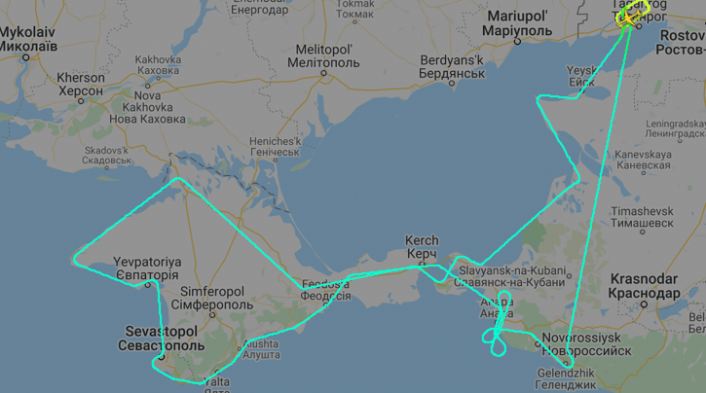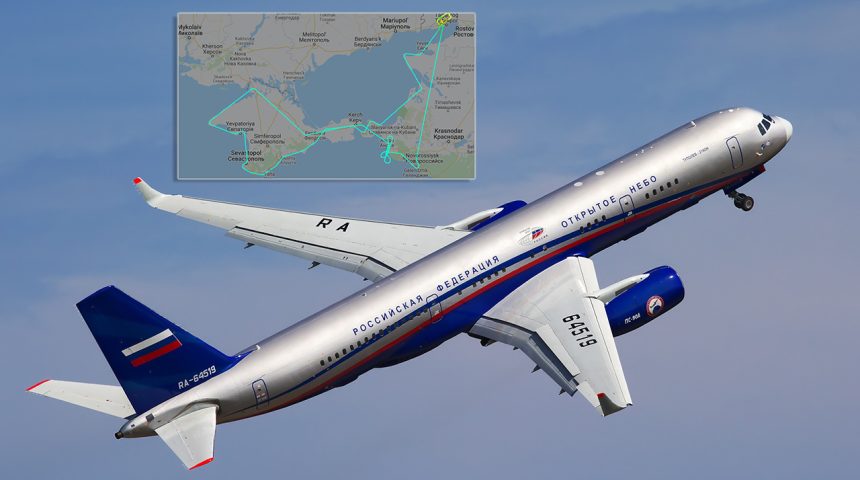One of the Tu-214ON aircraft used for Open Skies observations carried out a different type of surveillance mission near Crimea at the beginning of this month.
The Tu-214ON (Otkrytoye Niebo – Open Skies) is a highly modified Tu-214 airliner equipped with advanced photo and electronic sensors to perform Open Skies Treaty surveillance missions.
The Treaty on Open Skies, which entered into force on Jan. 1, 2002, establishes a regime of unarmed aerial observation flights over the entire territory of its participants with the aim to enhance mutual understanding and confidence by giving all participants, regardless of size, a direct role in gathering information about military forces and activities of concern to them.
In November 2020, the U.S. announced the withdrawal from the Open Skies Treaty, on the basis of the alleged repeated Russian violations of the treaty, as the refusal to allow access to observation flights within a 10 km corridor along the country’s border with the Russian-occupied Georgian regions of Abkhazia and South Ossetia, as well as restrictions placed on using airfields in Crimea.
The U.S. withdrawal from the treaty in November 2020 “destroyed the balance of interests of the State-Parties reached when the Treaty was signed, inflicted a severe damage to its functioning, and undermined the role of the Open Skies Treaty as a confidence and security building measure,” the Russian Foreign Ministry said on Jan. 15, 2021. For this reason, Russia announced it also started the domestic procedure to withdraw from the treaty, although Moscow clarified it could reverse the decision if the United States returned to the agreement.
While such exit procedure should be completed by this summer, it looks like the two Tu-214ON with registrations RF-64519 (ex RA-64519) and RF-64525 (ex RA-64525) used for treaty observation missions, have already started flying a different kind of reconnaissance mission, to monitor the security of Russia’s military facilities.
According to the Russian State outlet RIA Novosti, at the beginning of the month, one of the Tu-214ON aircraft checked the camouflage of military facilities on the coasts of Crimea and Krasnodar, and also tested the capabilities of the air defense system of these regions.
Indeed, on Mar. 4, 2021, RF-64519, departed from Taganrog airfield, in southwest Russia (home to the Taganrog Beriyev Aviation Scientific-Technical Complex) and flew a reconnaissance path along the coasts of Krasnodar and Crimea. Its mission was to check the camouflage and security of the military facilities and units located there, including the naval bases in Sevastopol and Novorossiysk. It looks like the Tu-214ON was also used to test the ability of the regional air defense system to detect air targets in a passive location mode.
Based on the track recorded by Flightradar24.com, the mission lasted 3 hours and 45 minutes. The aircraft operated at 300kts and 9,800 feet.

The Tu-214ON was designed as an open architecture, meaning that it can accommodate different sensor packages. For instance, according to Russia’s Warplanes Vol. 1 by Piotr Butowski, the Tu-214ON can carry the M402N Ronsar side-looking radar with synthetic aperture with a range of 50 km over land and 200 km over water with a definition of 3m over land and 6-8m over water; dual-band Raduga IR scanner; a photo camera suite that includes a panoramic, a vertical and two oblique cameras; and a TV camera suite (one vertical and two oblique cameras). For the initial Open Skies missions, the aircraft carried the digital electro-optical sensor OSDCAM4060, the same as the An-30B and Tu-154M LK-1 (the previous types used for treaty sorties).
Therefore, unless the decision to leave the treaty is reversed, the Tu-214ON will probably be used to check the maskirovka (camouflage/masking) of military installations and units, so that they can train to hide from enemy surveillance assets. Sounds interesting. We will provide additional details as they become available.









